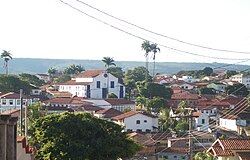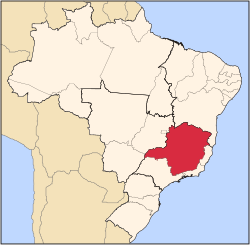The economy is centered on gold mining and agriculture.
Mining
In Paracatu, gold has been mined since 1722. [3] The Morro do Ouro (Paracatu) open-pit mine is operated by Rio Paracatu Mineração (RPM), a 100% owned subsidiary of the Canadian company Kinross Gold Corporation. The gold content of the ore is comparatively low, about 0.41 gram of gold for every ton of ore extracted. Annual production is about 15 tonnes of gold and 5 tonnes of silver. [4] [5]
Kinross Gold owns the open-pit Paracatu gold mine operated as Kinross Brasil Mineração S.A. that includes two process plants, two tailings facilities, as well as accompanying infrastructure. [6] This mine is the region's largest employer. [7] In 2015, Paracatu produced 477,662 gold equivalent ounces. [8]
Agriculture
Cattle raising is the main agricultural activity with 231,000 head (1996). The main breeds are: Zebu (Gir, Indu-Brasil, Guzerá and Nelore), Girolanda, Frisian and Brown-Swiss. There is also large production of soybeans, corn, rice, beans, and also some coffee. Paracatu is the commercial center for an area one third the size of Portugal. In 2006 there were 6 banking branches: Banco do Brasil, Itaú, Bradesco, Banco Mercantil, Banco Bamerindus, and Caixa Econômica Federal. [9] The GDP was R$754,090,000 (2005). [10]
In 1978 the municipality began to receive investments from the Brazilian and the Japanese government to develop the cerrado soils, through the PRODECER-Programa de Cooperação Nipo-Brasileiro para o Desenvolviemnto do Cerrado.
Because of new technologies used to develop the cerrado, agriculture in Paracatu became efficient and profitable in many properties. Nowadays, the cultivated area in the municipality surpasses 1000 square kilometres, with 300 square kilometres irrigated by central pivot sprinklers. This number has raised Paracatu to the position of greatest continuous area irrigated by center pivot irrigation in South America, using 318 center pivot sprinklers. [11]
Agricultural data
In 2006 there were 995 rural producers with total agricultural land of 389,095 ha. Of the total 85,000 ha. were planted, 180,000 ha. were in natural pasture, and 113,000 were in forest or woodland. Around 4,500 persons were employed in agriculture. There were 768 tractors. The planted area of some of the main crops in hectares was:
- Corn: 12,000
- Soybeans: 30,000
- Sorghum: 2,000
- Rice: 2,670
- Coffee: 1,050
- Cotton: 3,000
- Sugarcane: 1,600
- Beans: 9,100
- Watermelon: 1,050 [10]





